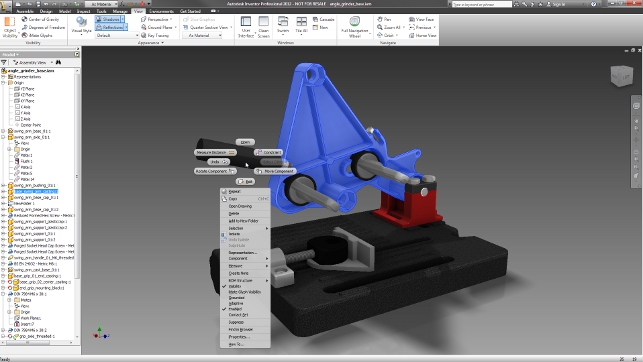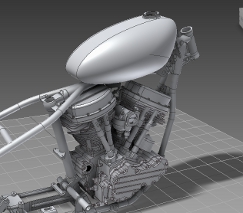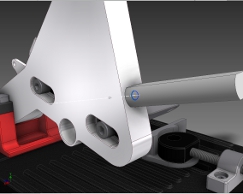Inventor, Autodesk’s flagship software for those engaging in product development, has now been on the market for nearly ten years. The last couple of releases have seen it go through a roller-coaster of updates, enhancement and redesigns.

New marking menus provide access to a context sensitive list of most commonly required operations and options
These range from the underlying UI changes that see it adopt the Microsoft Ribbon user experience guidelines to the rearchitecting of the display and visualisation engine that presents models in a compelling manner and down to the core updates in how the users interact with the model.
The system now feels more responsive to modelling and other interactions. For 2012, there is another shift upwards on the usability curve that brings all of this together to create a system that feels slick
when in use. Autodesk has done a belting job of shifting the focus away from dialogs and list-style right click menu to a much more direct interaction method.
Together with the standard dialogs mini-toolbars now pop up in the modelling window providing access to all of the options for a particular feature. But the real zinger is the marking or radial menu tools, which are now standard fare. These give a context aware selection of tools around the cursor with a command at each major compass point as well as the full right click menu that users have come to expect.
I’m a big fan of these types of UI methods as they tend to become ingrained in muscle memory very quickly, making you work more efficiently.
General modelling updates
In terms of specific modelling updates, there are a few big ones for this release.
The biggest news has to be the integration between standard Inventor and Inventor Fusion. For those unaware, Inventor Fusion is Autodesk’s take on the whole direct modelling movement.
Installed as a separate application, it gives the user access to freeform geometry editing and creation tools. It looks and feels like Inventor, but the whole thing is stripped back providing just the tools needed to make edits to geometry.
Perhaps the biggest shift is that Fusion now also includes the “Alias freeform” features, which were delivered with the last release cycle, but with a couple of key points. Firstly, while the last release required a license of Alias, this has now been removed.

The new G2 (curvature continuous) variable radius fillet options with the new minitoolbars in effect
The second is how the workflow has changed. Alias Freeform allows the user to edit a form using its edges and control points on those edges. While I could ramble on for pages about how beneficial these types of modelling tools are for exploring and creating form, instead we’ve put together a short workflow below.
Other key updates that are worth having in mind when exploring the new tools are extensions to other features that have been around for a while. For instance, Inventor’s been gaining high-order curvature support across a range of features. G2 (curvature continuous) fi llets were introduced in the last revision and this has been extended to support G2 with variable radius fillets in 2012.
This has been backed up with greater support for both patterning and mirroring of fillet features. The user is able to build cleaner models rather than having to replicate fillet features across common geometry. The lofting options also now have G2 continuity when working in suitable conditions such as building a loft off existing edges, obviously.
Simulation updates
Alongside modelling updates, a key area Autodesk has been investing in is simulation. In fact, it has spent half a billion dollars on simulation technology and associated companies in the last few years.
This technology always takes time to filter through to Inventor proper and each release brings more simulation tools into the fold. This release sees a few updates across a couple of disciplines.
In general terms, the ability to automatically convert assembly constraints to joints in the simulation environment will cut down on the doubling of effort that often accurs.
Of course, constraints intended for geometry might not always be those required for kinematic simulation, so the user can dive in and adapt them to get the movement and functionality needed.
There’s also been a focus on the support within Inventor for frame design. Again, this has been done over the last few releases, but this release sees additional tools added to conduct analysis of such welded forms.
Whether that’s auto creation of mitres and joining of sections, more customisation options for beam profiles and section or more control over continuous loading conditions, which can be fine tuned as per
the user’s needs.
Integration & suites
One of the big things for the Inventor 2012 release is how the system is packaged. In essence, Autodesk now offers a range of suites that package Inventor along with other
related software, usually at a dramatically reduced cost.
For example, the base level Inventor Suite contains Inventor, AutoCAD Mechanical, all of the modelling functionality such as sheet metal design, plastic part design, along with ancillary tools such as Showcase (for visualisation), sketchBook designer (for concept development), Vault (for data management) and Mudbox (for polygon mesh-based modelling).
On top of this core offering, there are then task or industry specific options, such as Ultimate, which includes all of the Inventor options (such as tooling, routing and piping), Alias and 3ds max Design.

Inventor’s visualisation engine continues to be developed. Now including realtime rendering at the hit of a button. (Frame and Engine model courtesy of Terry StoneHocker via Grabcad)
There are options for tooling design, for simulation and for factory layout. It’s worth spending some time with your VAR to find the best fit.
The 2012 release cycle sees Autodesk pushing a much wider range of its technology and products to the Inventor user. With some the user can jump right in and start taking advantage of immediately.
Showcase is a given. It allows you to load up an Inventor model and use it for both rendering and visualisation work, design review and such (We’ll be taking a good look at Showcase in the next issue).
Vault is another. Then things like Mudbox seem a little out of place but, to be honest, with the amount of technology available it’s almost worth spending the time to learn it and see if it can fit into your workflow.
It’s interesting that Autodesk is not only building out these offerings with discreet products but it’s also working on integration between the various constituent parts. The Factory Design offering is a solid example as the system can transfer data intelligently between Inventor, AutoCAD and NavisWorks.
Another good example is the work done to bring across more intelligence from Inventor into Showcase. Showcase can now read in Design Views as Alternatives, Inventor constraints are imported as Showcase behaviours, so the user can reuse them for creating animations without all the hassle of key-framing them manually.
Environmental impact
With the 2012 release, Autodesk has worked with the team at Granta Design to develop the Eco Materials Adviser. Those that read our first DEVELOP3D Sustainability supplementwill be aware of this, but a quick recap is in order, I think.
The concept is that you can take your assembly, define the materials your product is manufactured from, add in information about the processing of the material (whether it’s machined, injection moulded, etc and the location of that work and the system will provide you with information about the environmental impact of that product concept – whether that’s carbon footprint, energy or water use and whether it’s conformance with RoHS standards (which restricts the use of specific hazardous subjects).
The free version does a good amount but there’s a restriction of materials and the number of parts in a single assembly you can include. There is also an upgrade available which will give you a wider range of materials from Granta Design’s world leading material information and more data in the impacts.
Conclusion
I’m pretty sure I’ve missed a tonne of content and there’s a huge amount of updates to some of the more task specific tools in Inventor and ancillary applications around that we’ll explore over the coming months.
But what should be clear is that Autodesk is doing some interesting things with Inventor these days. From the exploration and refinement of new user interaction methods (driven by the Inventor Fusion project on Autodesk labs), through greater integration with simulation, visualisation and into the realms of digital technical documentation with Publisher – Autodesk is pushing its technology stack into
some interesting directions and certainly beyond that pure ‘AutoCAD and Inventor’ focus of the systems’ early years.
The whole move towards a ‘suite’ based sell where everything is bundled into a single package or variants thereof is something I’m undecided about. The idea that you can have Alias Design, Inventor Professional, Showcase (the hidden gem of the product range) as well as all the other things, for not a massive amount more than Inventor Professional, represents incredible value.
That said, if you’re in a high-pressure commercial environment, will you and your team have the time to dig in and learn these new tools as well as get up to speed on the updates to just Inventor alone? I’m less convinced.
In terms of what existing users need, you’ll end up with one of these ‘suites’ to replace your existing product stack. That means chances are you’ll have some brand new software at your fingertips. I’d say its worth experimenting and seeing what’s there. Showcase in particular, is fantastic as a way of visualising and presenting a design concept.
As a final note on Inventor specifically, the system is maturing rapidly. Yes, it still has some room to grow in terms of handling complex forms and operations but with each release it’s looking more like a leader rather than a follower.
| Product | Inventor |
|---|---|
| Company name | Autodesk |
| Price | on application |








